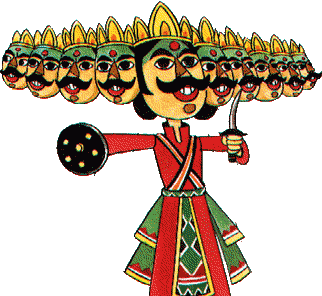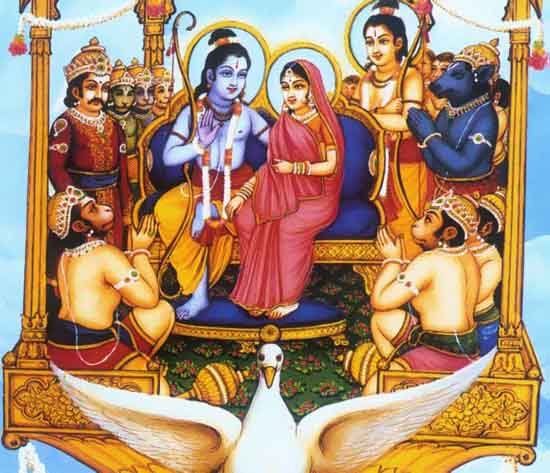|
|
 Dussehra
Dussehra
The festival of Dussehra
is the principle celebration in many parts of the country. It is celebrated
with great fanfare in Kullu, Varanasi, Mysore and slightly differently
as Durga puja in West Bengal.
Dussehra is the most popular
festival in India. It is a Hindu festival, which is celebrated all over
India to mark the defeat of Ravana by Lord Rama. Dussehra also symbolises
the triumph of warrior Goddess Durga over the buffalo demon, Mahishasura.
The 'Ramlila' - an enactment
of the life of Lord Rama, is held during the nine days preceding Dussehra.
On the tenth day (Dussehra or Vijay Dasami), larger than life effigies
of Ravana, his son and brother -Meghnadh and Kumbhakarna, are set to fire.
The theatrical enactments of this dramatic encounter are held throughout
the country in which every section of people participates enthusiastically.
In burning the effigies the people are asked to burn the evil within them,
and thus follow the path of truth and goodness, bearing in mind the instance
of Ravana, who despite all his might and majesty was destroyed for his
evil ways.
Legends
This day is also known as
Vijaya Dasami, because of the victory of Ram over Ravana. On this day in
Satya Yug, Ram (the eighth incarnation of Lord Vishnu), killed the great
demon and king of Lanka, Ravan. Puranas also opined that in this day warrior
Goddess Durga defeated and killed the buffalo demon Mahishasura.
Rituals
Worship of the Goddess
is the oldest tradition, significant in this case as it represents the
female deity's supremacy over the male Gods who unable to destroy the demon.
The worship of Durga Mata has also social implications. As Goddess of war,
she is a particular favourite of the Kshatriyas, the warrior caste, once
constituting the ruling elite and aristocracy.
During this time People decorate
the entrances of their homes with torans, and flower studded strings. As
the evening falls, the villagers cross the border, a ritual known as Simollanghan,
and worship the Shami tree. The leaves of the Apta tree are collected and
exchanged among friends and relatives as gold. Dusshera Puja in India varies
from place to place. It differs region to region and it is influenced by
local myth and religious beliefs. The festival is also celebrated with
intense fervour and zest, in West Bengal. The vibrant festivities last
for ten days, of which nine nights are spent in worship, 'Navaratri'. The
tenth day is devoted to the worship of goddess Durga, who occupies a special
position in the Hindu pantheon of gods and goddesses. She is 'Shakti',
the cosmic energy that animates all beings. Beautiful idols of the Mother
Goddess are worshipped in elaborate pandals for nine days, and on the ninth
day, these are carried out in procession for immersion (visarjan) in a
river or pond.
Celebration:
In Himachal Pradesh, a week
-long fair in the hill town of Kullu, is a part of the Dussehra celebrations.
From the little temples in the hills, deities are brought in procession
to the 'maidan' in Kullu, to pay homage to the reigning deity, Raghunathji.
The celebration actually begins nearly 10 days in advance as per tradition.
In Mysore, Karnataka the Mysore palace is illuminated for a whole month
during Dusshera and caparisoned elephants lead a colourful procession through
the gaily-decorated streets of the city. It is the most colourful celebration
of Dusshera in world. The spectacular procession taken out on this day
is really enjoyable. In Tamil Nadu, the first three days are dedicated
to the worship of Lakshmi, Goddess of wealth and prosperity, the next three
days to Saraswati, Goddess of learning and arts and the last three days
to Shakti (Durga). In Tamil Nadu, Andhra Pradesh and Karnataka, families
arrange dolls (Bommai Kolu) on artificially constructed steps and prepare
an elaborate spread of lamps and flowers. Women traditionally exchange
gifts of coconuts, clothes and sweets.
|
The whole set up is put
up on the very first day of Navaratri. After the Saraswati pooja on the
ninth day, the whole set up is taken down on Vijayadashmi. Vijayadashami
is an auspicious occasion for children to commence their education in classical
dance and music, and to pay homage to their teachers. In Punjab, Navaratri
is taken as a period of fasting. In Gujarat, the evenings and nights are
occasions for the fascinating Garba dance. The women dance around an earthen
lamp while singing devotional songs accompanied by rhythmic clapping of
hands. |
In northern India, the festival
wears the colourful garb of Ramlila wherein various incidents from Rama's
life are enacted, as is the destruction of Ravana and Bharat Milap, that
is the reunion of Ram and his estranged brother Bharat, on the former's
return to Ayodhya after 14 years of exile. Under Ramlila important and
interesting episodes of Ramayana are enacted. These draw large number of
people every year. The entire night of Dussehra passes in an enthusiastic
and enchanting fair like ambiance and people enjoy every bit of it. After
Dussehra, the excitement of the Diwali grips the India.

|
|






